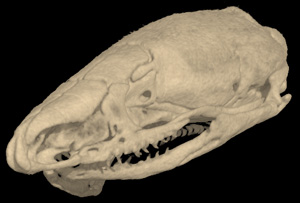The data on this page are the subject of a paper entitled Comparative skull morphology of uropeltid snakes (Alethinophidia: Uropeltidae) with special reference to disarticulated elements and variation by J.C. Olori and C.J. Bell (PLoS ONE 7(3): e32450). The abstract is as follows:
Uropeltids form a diverse clade of highly derived, fossorial snakes that, because of their phylogenetic position among other alethinophidian lineages, may play a key role in understanding the early evolution of cranial morphology in snakes. We include detailed osteological descriptions of crania and mandibles for eight uropeltid species from three nominal genera (Uropeltis, Rhinophis, and Brachyophidium) and emphasize disarticulated elements and the impact of intraspecific variation on previously proposed morphological characters used for phylogenetic analysis. Preliminary analysis of phylogenetic relationships strongly supports a clade composed exclusively of species of Plectrurus, Uropeltis, and Rhinophis. However, monophyly of each of those genera and Melanophidium is not upheld. There is moderate support that Sri Lankan species (e.g., Rhinophis and Uropeltis melanogaster) are monophyletic with respect to Indian uropeltids. Previously proposed characters that are phylogenetically informative include the shape of the nasals, length of the occipital condyle, level of development of the posteroventral process of the dentary, and participation of the parietal in the optic foramen. Additionally, thirty new features that may be systematically informative are identified and described, but were not verified for their utility. Such verification must await availability of additional disarticulated cranial material from a larger sample of taxa. All characters require further testing through increased focus on sources and patterns of intraspecific variation, inclusion of broader taxonomic samples in comparative studies, and exploration of skeletal development, sexual dimorphism, and biogeographic patterns. Additionally, trends in the relative enlargement of the sensory capsules, reduction in cranial ossification and dentition, fusion of elements, and the appearance of novel morphological conditions, such as the structure and location of the suspensorium, may be related to fossoriality and miniaturization in some uropeltid taxa, and may complicate analysis of relationships within Uropeltidae and among alethinophidian snakes.

The specimen was scanned by Richard Ketcham on 19 September 2003 along the coronal axis for a total of 1175 slices. Each 1024x1024 pixel slice is 0.01495 mm thick, with an interslice spacing of 0.01495 mm and a field of reconstruction of 14 mm. The original 16bit-TIFF data set can be downloaded here.










